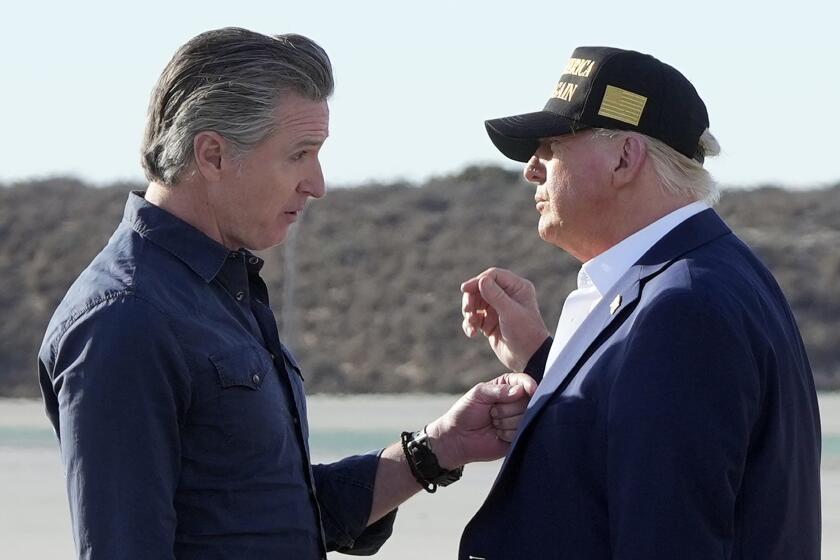2 Doctors’ Actions Rocked ‘the Rock’
- Share via
In its 120 years, “the Rock”--as County-USC Medical Center is known to its staff--has endured doctors’ strikes, scandals, epidemics, pistol-wielding gunmen and Proposition 13. But in all that colorful and traumatic history, there are few characters to match the cigar-chomping, pioneering cancer surgeon who purposely flicked ashes and spit into incisions when not strolling the hospital’s corridors in his hooded yellow bathrobe.
More than 70 years ago, this operating room wizard was a popular but controversial champion of something he called cautery surgery, a rare promise of help to cancer sufferers living on hope and longshots in the era before chemotherapy and radiation.
It was shortly after the turn of the century that Dr. James Fulton Percy developed the idea of using an electric rod to deliver a large amount of heat to a small spot, such as the location of a tumor. He modestly named his invention the Percy cautery.
New Jersey-born during the Civil War, Percy earned his medical degree from New York University and completed his residency at nearby Bellevue Hospital in 1886. While traveling and studying throughout Europe, he earned a postgraduate degree in pathology and surgery.
In 1923, Percy arrived at Los Angeles County Hospital, not in hopes of getting rich, but for the opportunity to teach and conduct research. As a founding member of the hospital’s Tumor Board, he weighed agonizing choices in the treatment of cancer.
Hunkering down in a square of sunlight from the open window that served as a conduit for both bacteria and fresh air, Percy attacked his patients’ cancers with his glowing, cherry-red soldering iron, considered by some an instrument of quackery and by others a medical marvel.
For more than two decades, he wielded the cautery iron steadily and confidently on the most critical of the critically ill, providing a running commentary for the benefit of wide-eyed residents such as young Murray Zimmerman.
Mesmerized, Zimmerman--who went on to become a Whittier dermatologist--watched in awe as Percy, like an artist, removed a tumor from the cheek of a patient, something most physicians refused to do surgically for fear of damaging the facial nerve.
When Percy cauterized a tumor’s blood supply, clouds of smoke from burned tissue and an awful stench filled the operating room. At other times, while Percy propounded his decidedly unconventional notion that “bacteria is good for [treating] cancer,” doctors watched in horror and amazement as the surgeon flicked his cigar ashes and spit into the patients’ open abdominal cavities.
The hospital’s pathologist, Dr. George Maner, was one of the few physicians willing to scrub up to assist Percy; most did not want the job. The operations lasted too long, six hours or more. And, although Percy’s irreverence and sarcastic attitude toward gore were his way of dealing with deadly illness, many other staff physicians considered him “overly enthusiastic” with his cautery.
In fact, the mortality rate for his operations was high, although the disease was alleviated in some patients. But while hospital administrators were fiercely critical of Percy’s methods, desperate patients often opted for his technique as a last-ditch effort.
Hospital historians still recall the high energy Percy always radiated on surgery days, a quality no doubt fueled by the spicy mock turtle soup he always ordered from the hospital cafeteria. Such special arrangements were common at County in those days, when staff doctors imperiously called the shots. Special foods and a separate dining room were the norm.
At least they were until a soon-to-be-unpopular medical director, Dr. Neal Narramore “Narrow-Minded” Wood, took over and began writing a new prescription for staff and patients alike.
Wood fundamentally altered the relationship between the county hospital and its professional staff, turning doctors into public employees. He required written passes for interns and residents to leave the grounds, restricted the noise level in the interns’ quarters, canceled poker games in the doctors’ lounge whether played on or off duty, discouraged holiday parties, prohibited threatening or scolding of a patient and encouraged the use of fly spray to rid the facility of bothersome insects.
Doctors Revolt
Stung by the loss of prerogatives, residents and interns launched a veritable revolt against Wood’s administration. But instead of walking a picket line or withholding care, which would have violated their Hippocratic oath, the unhappy doctors decided to fight back with an excess of care and dedication.
The entire medical staff refused to discharge patients without first getting upper and lower GIs and psychological consultations. Although some patients enjoyed the longer stays, others fumed.
As the wards bulged at the seams, Percy and other senior staff members simply viewed the ploy with sardonic amusement.
With an erupting crisis on his hands, Wood soon relented and the doctors’ separate dining room reopened, cafeteria employees returned to holding the best food for physicians too busy to grab some during regular hours, and nurses were instructed “to be nicer to the doctors.”
As the atmosphere improved, Wood started to turn his energy toward planning the building of the new hospital.
But, in 1932, a year before the new structure opened, Wood was demoted and removed from his job after the county Board of Supervisors and future mayor Frank L. Shaw had the hospital investigated for alleged corruption. Shaw himself would be recalled on similar charges six years later.
Although some doctors burned out quickly under the pressure, Percy seemed to thrive, his popularity and eccentricity increasing with the years.
Until his death in 1946 at age 82, Percy continued to relish the joy of smoking his beloved cigars, and although his habitual preference for a bathrobe over a surgical gown often led others to mistake him for a psychiatric patient as he stalked the hospital corridors, he died the dean of L.A. surgeons.






